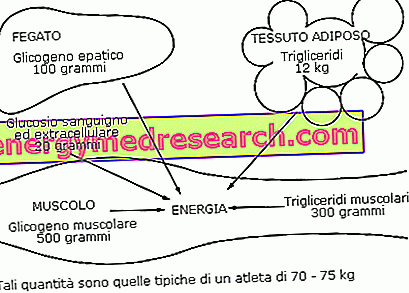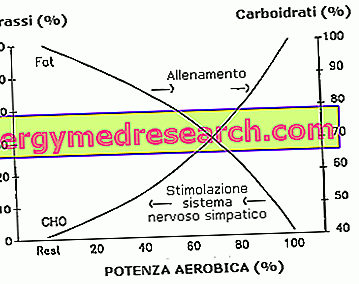This article aims to clarify once and for all what is the ideal heart rate for weight loss, given the great confusion and summary information circulating on the subject.


Looking at the image above, we open a small but very important parenthesis on the body's energy fuels. As shown in the figure, under normal conditions intramuscular sugars amount to about 300-500 grams, to which are added about 100-150 grams of liver and the small amount of glucose circulating in the blood, where it is kept at fairly constant levels ( glycemia). Another very important fuel is given by the fats, crammed in very high quantities in the adipose tissue and to a lesser extent among the muscle fibers. In the image the third fuel of the organism is not indicated, used above all when the reserve light of the sugars is turned on; we are talking about muscle amino acids and the amino acid pool in the blood. The contribution of creatine has been deliberately omitted, as it is beyond the scope of this article.
At this point, before discussing the ideal heart rate for weight loss, it is essential to illustrate two key concepts:
carbohydrates, also called carbohydrates or sugars, are the most effective fuel, able to bring the human machine to the highest performance levels;
at the same weight, lipids supply more energy than sugars in absolute terms (9 Kcal / g against 4 of carbohydrates), but not in relative terms, because the greater the amount of oxygen needed to generate this energy. It follows that lipid fuel produces lower performance levels than those that can be generated with the use of sugars.
The limiting factor for the consumption of lipids for energy purposes is therefore given by the availability of oxygen at the level of the individual muscle fibers; more energy is required by the effort and more oxygen is consumed. But what does the proportion of oxygen that can be used by muscles depend on? The main limit is not placed at the pulmonary level, but peripheral; this means that larger lungs or larger airways do not guarantee large performance gains. Rather, the plasma concentration of red blood cells and hemoglobin significantly affect performance, and at the muscular level the density of the capillary bed, the fiber composition (white and red), as well as the number, size and efficiency of the enzymes that catalyze the reactions energy. The more these systems are efficient, the greater the percentage of lipids burned during efforts of important intensity; sugars are in fact limited, so the body tries to save them by using mainly fats.
From the above it can be easily deduced that:
the more the intensity of the exercise rises and the greater the percentage contribution of the sugar fuel becomes. Conversely, in order not to attack the limited reserves of these nutrients, in the lightest efforts the body burns mainly fats.
Some significant data:
IF PHYSICAL ACTIVITY IS LOW-INTENSITY AND SHORT-LENGTH (EX. RUNNING FLOOR, "WITHOUT FIATONE" FOR AT LEAST 20-30 MINUTES), LIPIDS AND CARBOHYDRATES CONTRIBUTE TO THE MEASURE OF THE COVERAGE OF THE ENERGY REQUEST. VICEVERSA, IF PHYSICAL ACTIVITY IS LOW-INTENSITY BUT PROPOSES FOR AT LEAST AN HOUR, THERE IS A PROGRESSIVE DEPAUPER OF GLYCOGENOUS RESERVES, CONSEQUENTLY INCREASING THE USE OF LIPIDS, WHICH ARE FINDING TO COVER 80% OF THE ENERGY REQUEST.
In particular, it is estimated that 60 to 90 minutes of very intense exercise are sufficient to significantly reduce carbohydrate stocks. If at the end of the exercise these are close to exhaustion it will then be necessary 24 - 48 hours to reconstitute them.
According to what has been said, a theoretically effective way to lose weight would be to train when the carbohydrate stocks have already been significantly reduced by a previous training, a low-calorie diet or an overnight fast. This is a potentially useful solution, but with a series of limits that we have analyzed in the dedicated article.
The points just illustrated are the basis of the aforementioned theory that the optimal heart rate for weight loss would be around 60-70% of HRmax (at this exercise intensity the fuel mixture used is very rich in fat). Unfortunately, this is a simplistic and fundamentally wrong reasoning, for a whole series of reasons:
- if we want to be able to burn fat for energy we must first of all take care to increase the amount of oxygen that reaches the muscles. So how can we increase the density of mitochondria, enzymes and capillaries in the muscles? Simply engage in long duration training (minimum 50 ') with a heart rate of 60-70% of HRmax; in practice, just do what most instructors recommend for weight loss. This rule applies especially to the sedentary or for those coming from a long period of suspension of training. The program will be maintained for a period varying from four to ten weeks, during which, however, it will be possible to insert extensions and short sections with a slightly higher intensity. The purpose of this first phase is to be able to run for at least 40 minutes at low intensity without pauses and with relative ease.
- It is now known that the calorie consumption of the walk is about 0.5 KCal per kg of body weight, just over half of what it burns when running. Therefore, a subject of 100 kg that runs for 10 km burns around 1000 KCal, regardless of the intensity of the exercise. In fact, the caloric consumption per km of the slow run is very similar to that per km of the race carried out to the maximum of its possibilities; what changes, in these cases, is only the mixture of fuels used: richer in fats in the first case and richer in sugars and amino acids in the latter.

- There is also a third element, little known, which explains why the heart rate for weight loss must still be demanding. We are talking about the oxygen debt. At the end of a physical exercise the metabolic activities do not immediately return to their level of rest, but they need a more or less long time depending on the intensity and on the duration of the exercise. The more the effort has been demanding, the longer this period is. In practice, therefore, we are emphasizing that the sportsman continues to burn more calories than normal even for a certain period of time after the end of the exercise, a period that will be the longer the more intense and lasting the effort that preceded it was. This phenomenon is explained by the need to restore energy stocks, dispose of lactic acid, transform it into glycogen (Cori cycle), re-oxygenate myoglobin and repair macro and microscopic structures damaged by exercise. Furthermore, the contribution of hyperthermia should not be underestimated (basal metabolism increases by 13% for each degree of increase in body temperature) and hormonal balance, with activation of stress hormones, acute (catecholamines) and chronic (glucocorticoids).
- If we want to make the most of what was stated in the previous point, we must rely on interval training, which consists of alternating routes with high intensity and recovery routes. In this way a very large oxygen debt is created, partially recovered and a new one is created; the intensity of the training reaches the stars and with it the calorie consumption. Rightly, with this technique the percentage of fat used will be quite low, but the calories burned will rise dramatically both during and after the exercise. For all these reasons, we believe it is time to abandon the old theories that the ideal heart rate for weight loss should be between 60 and 70% of HRmax; therefore ask your instructor to prepare some cards focused also on jobs of intensity, without forgetting the right periods of recovery.




